Things to do in Budapest
Budapest's rich and diverse history makes for some exciting sightseeing opportunities. The attractions are varied, including luxuries such as spa treatments courtesy of the city's many thermal springs, culinary adventures sampling delicious traditional cuisine, and leisurely river cruises down the beautiful Danube.
Those interested in the history of the city should stroll through Memento Park, one of Budapest's strangest attractions, which features the giant statues that once lined the city's streets during the communist era, or marvel at the Royal Palace, which dates back to the 13th Century.
Other popular cultural sites include the Parliament Buildings along the banks of the Danube River, and the iconic Chain Bridge. Visitors can admire the stunning views from the vantage point of Fisherman's Bastion or from Gellert Hill, where they can also visit the Citadella and Liberation Monument.
Visitors would do well to purchase the Budapest Card, which will allow them unlimited travel on public transport, free or discounted entry into a number of museums and cultural sites, reductions on sightseeing tours, and discounts on restaurants, spas, and car rentals. The cards are valid for either 48 or 72 hours and can be bought from main metro ticket offices, tourist offices, travel agencies, hotels, or airport.
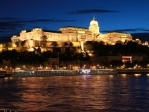
Buda Castle
Buda Castle is the royal complex of past Hungarian monarchs. Sitting atop Castle Hill in the picturesque Castle District of Buda, the royal palace was first inhabited by King Béla…
Buda Castle
Buda Castle is the royal complex of past Hungarian monarchs. Sitting atop Castle Hill in the picturesque Castle District of Buda, the royal palace was first inhabited by King Béla in the 13th century. Its strategic location straddling the Danube offered whoever controlled the city a defensive position and potential control of the main waterway. The castle has a mixture of architectural styles, ranging from Gothic to Baroque. Today, it's the country's most important cultural centre, housing numerous museums with the majority of the buildings being historical monuments. The Budapest History Museum contains an exhibition explaining the history of the city, as well as archaeological remains of the palace. Also within the palace complex are the Hungarian National Gallery, the National Library and the Ludwig Museum.
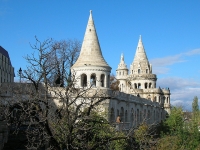
Fisherman’s Bastion
Built in 1905 on the medieval castle walls, the ramparts of the Fisherman's Bastion were so named after those whose duty it was to defend this side of the hill during the Middle Ag…
Fisherman’s Bastion
Built in 1905 on the medieval castle walls, the ramparts of the Fisherman's Bastion were so named after those whose duty it was to defend this side of the hill during the Middle Ages. The Romanesque Revival-style ramparts are purely ornamental, with gleaming white cloisters and stairways connecting seven turrets symbolic of the Magyar tribes that conquered the Carpathian Basin in the 9th century. Set back from the ramparts is an equestrian statue of King Stephen, a memorial to the founder of the Hungarian nation. The view from Fisherman's Bastion is outstanding at day or night, looking over the Danube, the Chain Bridge and the Parliament Buildings with Pest stretching out into the distance.
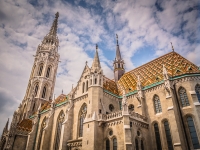
Matthias Church
Situated in the centre of the Castle Quarter, the 700-year-old Church of Our Lady is popularly known as Matthias Church. Its architecture is a mixture of styles from various occupa…
Matthias Church
Situated in the centre of the Castle Quarter, the 700-year-old Church of Our Lady is popularly known as Matthias Church. Its architecture is a mixture of styles from various occupations and periods. When the Turks occupied the Castle in 1541 it was converted into a mosque, and the interior walls were painted over with scenes from the Koran. Reconstructed in the 19th century in Gothic Revival style, remains of original medieval frescoes have been discovered underneath the whitewash. The interior is richly decorated with gilded altars, statues and rose windows, while the Church Museum gives access to the crypt and a small collection of religious artefacts and jewels. The church remains operational, hosting organ concerts and choir recitals beneath its multicoloured tiled roof and Gothic spire.
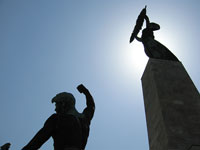
Gellert Hill
Gellért Hill offers unrivalled panoramic views of the city, taking in Buda, Pest and the meandering Danube. A monument of a martyred bishop stands at the base of the hill while on…
Gellert Hill
Gellért Hill offers unrivalled panoramic views of the city, taking in Buda, Pest and the meandering Danube. A monument of a martyred bishop stands at the base of the hill while on its summit stands the Liberation Monument, dedicated to the memory of troops who died freeing Hungary in 1945. Behind the monument is the Citadella, built after the Revolutions of 1848 to provide military control against further uprisings. The hill is also home to several historic spas, valued for their medicinal qualities. The city's most famous spa is the Gellért Baths, attached to the grand establishment of the Art Nouveau Gellért Hotel, where visitors relax in the thermal waters of a Roman bath with its lion-headed spouts, surrounded by columns and mosaics.
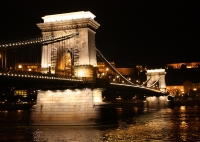
Chain Bridge
The Chain Bridge was the first stone construction built over the Danube and is the most famous in Budapest. Today, nine bridges link Buda to Pest but the Chain Bridge takes pride o…
Chain Bridge
The Chain Bridge was the first stone construction built over the Danube and is the most famous in Budapest. Today, nine bridges link Buda to Pest but the Chain Bridge takes pride of place as the city's primary landmark, a magnificent sight when floodlit at night. It owes its existence to Count István Széchenyi who decided to build a permanent crossing after having to wait a week to cross the river to bury his father. The Chain Bridge was built in 1849 by William and Adam Clark, who also constructed London Bridge. The iconic stone lions which guard the bridge were added to the bridge in 1852, miraculously surviving World War II even though the bridge itself was blown up in January 1945 and only resurrected in November 1949.
Website www.bridgesofbudapest.com/bridge/chain_bridge
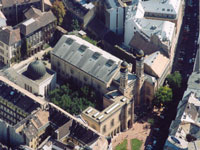
The Great Synagogue and Jewish Museum
Situated within the charming old Jewish Quarter of Pest, the Great Synagogue is one of the largest in the world. Its style is Byzantine-Moorish, with patterned brickwork in the red…
The Great Synagogue and Jewish Museum
Situated within the charming old Jewish Quarter of Pest, the Great Synagogue is one of the largest in the world. Its style is Byzantine-Moorish, with patterned brickwork in the red, blue and yellow colours of the city's coat of arms. Gilded domed towers, splendid archways and beautiful windows make this one of Budapest's finest landmarks. The splendid interior glitters with lights and gilded arches while balconies line the walls, while the ceiling is covered in Stars of David and the floor is tiled in decorative stars.
On Jewish festivals, it's packed with Jews from all over Hungary who come to celebrate within its splendour. Next door is the Jewish Museum, containing a Holocaust Memorial Room and relics from the Hungarian Jewish Community. In the courtyard is the Holocaust Memorial in the shape of a weeping willow tree, each metal leaf engraved with the names of those who have passed away.
Website www.greatsynagogue.hu
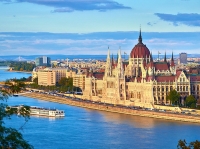
Hungarian Parliament
On the bank of the Danube stands the beautiful Hungarian Parliament, an imposing sight and a prominent feature of the city skyline. With its red dome, white stone lace ornamentatio…
Hungarian Parliament
On the bank of the Danube stands the beautiful Hungarian Parliament, an imposing sight and a prominent feature of the city skyline. With its red dome, white stone lace ornamentation and sharp spires, it's the city's most decorative structure. Stone lions flank the entrance guarding a rich interior of marble and gold, statues and columns. Magnificent artefacts are seen on guided tours, such as the 1,000-year-old crown of the first Hungarian King. The grand edifice, stretching for 250 metres (820ft) along the embankment, is one of the biggest national assemblies in the world.
Website www.parlament.hu
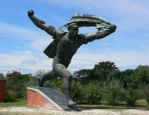
Memento Park
A popular yet bizarre attraction, Memento Park contains the giant figures of the communist era that once filled the streets of Budapest. Among them are the forms of Lenin, Marx and…
Memento Park
A popular yet bizarre attraction, Memento Park contains the giant figures of the communist era that once filled the streets of Budapest. Among them are the forms of Lenin, Marx and Engels, as well as memorials to Soviet soldiers and communist martyrs. There are also exhibitions detailing the history of the Soviet occupation in Budapest, contributing to a unique collection of artefacts and a fine location to educate oneself on the nature of communism.
Website www.szoborpark.hu
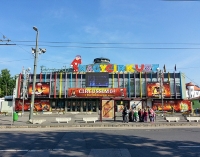
Capital Circus of Budapest
There's nothing kids love more than a circus performance and Budapest offers a fantastic display in the Hungarian tradition. The Capital Circus of Hungary (Fővárosi Nagy Cirkusz)…
Capital Circus of Budapest
There's nothing kids love more than a circus performance and Budapest offers a fantastic display in the Hungarian tradition. The Capital Circus of Hungary (Fővárosi Nagy Cirkusz) features an array of clowns, jugglers and acrobats, with the Hungarian Circus and Variety Non-Profit (MACIVA) playing an important role in Hungarian cultural life and is one of the oldest cultural establishments in the country. Originally opened in 1889, the circus has a school for performing artists and holds circus camps for children who want to learn. Special events such as parades and festivals occur at certain times of the year but show times and prices vary according to the season, so travellers should check the website for details.
Website https://fnc.hu/en/
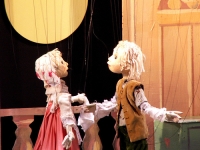
Budapest Puppet Theatre
The Budapest Puppet Theatre is a great outing for the whole family, ideal for those visiting Budapest with kids. While shows are all presented in Hungarian, children will remain en…
Budapest Puppet Theatre
The Budapest Puppet Theatre is a great outing for the whole family, ideal for those visiting Budapest with kids. While shows are all presented in Hungarian, children will remain enthralled by familiar stories such as Cinderella and Snow White. During enactments, the crowd can be heard calling out warnings when villains are approaching or encouraging heroes in their endeavours. It's amazing how little the language barrier matters when it comes to this kind of storytelling. The puppets are proper works of art and come in all shapes, sizes and colours, with some easily recognisable characters and some creative originals. Most adults will enjoy the performances too but can easily head for the cafe during the show.
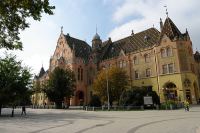
Kecskemet
A 53-mile (86km) drive from Budapest, Kecskemét makes for a wonderful excursion. While this garden city is quite large, the place has a uniquely small-town charm. Walking around t…
Kecskemet
A 53-mile (86km) drive from Budapest, Kecskemét makes for a wonderful excursion. While this garden city is quite large, the place has a uniquely small-town charm. Walking around the scenic city centre is pleasant, with the abundance of open squares and avenues peppered with colourful Art Nouveau buildings. There are a number of attractions in Kecskemét that visitors enjoy, including the distillery tours at the Pálinka Museum, the Hungarian Museum of Photography and the Museum of Hungarian Folk Art and Handicrafts, as well as the beautiful architecture and art collections at the city hall. Kecskemét has existed in some form since at least the 14th century, so it's no surprise that it holds so many old and hidden gems.



